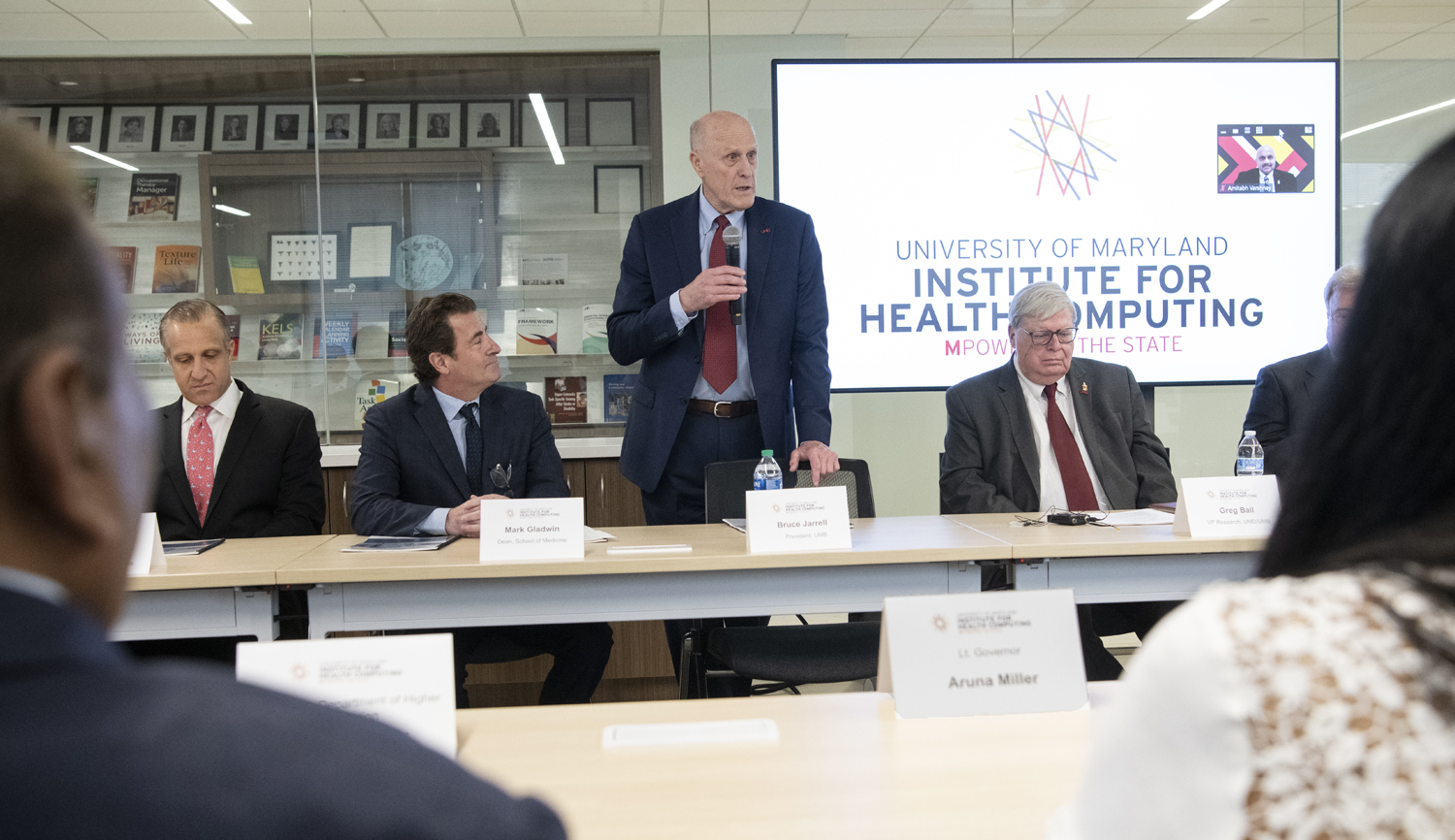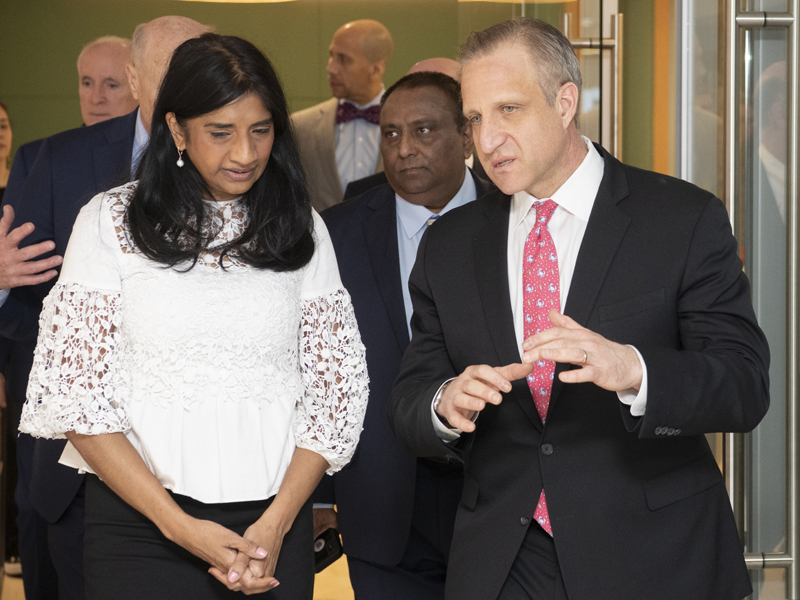“This is really, really exciting,” Maryland Lt. Gov. Aruna Miller told a gathering of 50 scientists and policy leaders at the University of Maryland Institute for Health Computing (UM-IHC) in North Bethesda on March 8. “Please know that this state is a partner with every one of you. Whatever we can do, to be able to succeed here in Montgomery County means we succeed over the entire state of Maryland.”
The UM-IHC is a strategic initiative that aims to improve the health and well-being of those living in Maryland and beyond using advanced computing tools like artificial intelligence, machine learning, and network medicine to create a premier learning health care system. It merges top-tier computational expertise and biomedical research with a vast clinical care network that is diverse socioeconomically and geographically. This network includes access to clinical trial data and de-identified electronic health records from 2 million patients in the University of Maryland Medical System.
“We see this as the East Coast Silicon Valley for health computing,” University of Maryland School of Medicine (UMSOM) Dean Mark T. Gladwin, MD, explained. The center’s location also brings significant benefits, he added. “Why here? We’re on the Red Line. Montgomery County has more than 320 companies. We’re here by NIH, FDA, multiple biomedical partners, and research facilities. We’re by IBBR [Institute for Bioscience and Biotechnology Research], USG [Universities at Shady Grove]. And again, we're a triangle between UMB, College Park, and this incredible, vibrant location. So, we're looking to build the economy through partnerships, and the development of new commercial entities in the space of artificial intelligence.”

(l-r, Bradley Maron, Mark Gladwin, Bruce Jarrell, and Greg Ball, PhD, VP of Research)
The institute’s staff has only very recently moved into its new headquarters. The team has already generated results from its first analyses and anticipates scaling up its analytical operation in the next two months, which will be fueled by the activation of the institute’s high-performance computing center.
The 10-year sublease comprises more than 27,000 square feet of state-of-the-art technology and office space, which will serve as IHC’s home until a planned $200 million facility is completed at the North Bethesda Metro Station.
Both UM-IHC’s current temporary and future locations include space for federal science partners to improve collaboration within the bioscience community.
“The FDA has already signed a memorandum of understanding with us and they are looking forward to expanding the machine learning and AI group in very close partnership with the Institute for Health Computing,” explained Amitabh Varshney, PhD, dean of the College of Computer, Mathematical, and Natural Sciences at the University of Maryland, College Park (UMCP). “So, we see this as a partnership that reinvigorates and revitalizes the fantastic opportunities between the federal government, industry, and the universities right here in Montgomery County and in the state of Maryland.”
Gladwin noted that UM-IHC has already received its first of what are expected to be many grants to perform medical studies. Rozalina McCoy, MD, MS, associate professor of medicine at UMSOM, will use big datasets to determine if new weight-loss drugs are as effective or more effective than bariatric surgery.
“Every step we take is looking to advance clinical outcomes, particularly focusing on health equity,” said Bradley A. Maron, MD, professor of medicine at UMSOM and co-director of the UM-IHC.
To illustrate the power of data science, Maron showed the group an analysis of the smoke infiltration from the Canadian wildfires last June, which increased by fivefold the amount of harmful chemicals in the air over communities all over the East Coast, like Baltimore.

Lt. Gov. Miller with Bradley Maron
“We then determined that this event was associated with a 40 percent rise in the need for people to see a heart or lung doctor just in that period of time,” Maron said. “This enables us to predict these events in the future and be prepared to deploy resources to affected or at-risk populations all across the region, regardless of their location or regardless of their risks that we know today.”
The key to any useful analysis of medical data is the size and quality of the dataset, explained Warren D’Souza, MD, MBA, chief innovation officer at the University of Maryland Medical System (UMMS) and adjunct professor of radiation oncology at UMSOM. UMMS is a 12-hospital system headquartered in Baltimore but serving the citizens of the entire state of Maryland, delivering approximately 25 percent of the hospital-based care in the state, which means the ability to access the de-identified electronic health records from UMMS patients will be invaluable for answering urgent public health questions.
“As Dr. Maron alluded to, we serve very diverse communities in urban, suburban, and rural areas in the state of Maryland,” he explained. “We believe that the technological and computational advances at the IHC and the clinical trials that we conduct through the IHC will have an incredible impact on the patients we serve, and the citizens of Maryland.”
Another speaker, Esa Davis, MD, MPH, associate vice president for community health and director of health equity at UM-IHC, amplified the significance of the diversity of UMMS’ patient records.
“We have at the IHC a real opportunity to improve our health equity by transforming how we conduct community-focused research,” she said. “With our data science and data systems or new analytic techniques, such as AI, we're able to conduct large, neighborhood-focused and community partner research. That gives us the ability to identify and engage communities that experience health disparities and are often left out of large trials. We're also able to show whether or not these communities are receiving the interventions or therapeutics that meet the guidelines to improve health outcomes and inequities.”
Davis also explained that UM-IHC hopes to develop new measures and ways of understanding the root causes of health inequities, including social drivers of health, and bias.
Since its launch in November 2022, the UM-IHC has been established into six core research areas:
- Applied Artificial Intelligence
- Bioinformatics
- Immersive Visualization
- Therapeutic Target Discovery
- Population and Community Health
- Real-World Evidence and Adaptive Clinical Trials
“We have a major opportunity to leverage new technologies to bring lifesaving therapies and new drugs and clinical trials to all the patients of Maryland, whether in West Baltimore or the Eastern Shore,” said Gladwin, who is also the John Z. and Akiko K. Bowers Distinguished Professor of UMSOM and vice president for medical affairs at University of Maryland, Baltimore. “For example, we're now launching programs that use data science to identify women who are newly pregnant and have hypertension that are of high risk for preeclampsia and high mother-baby mortality.”
Funding support comes from strategic partner Montgomery County, Maryland, and from the state of Maryland’s MPowering the State initiative. So far, Montgomery County has committed $40 million to the project over five years, matched by a $30 million commitment from UMB and UMCP via their 12-year collaboration, the University of Maryland Strategic Partnership: MPowering the State (MPower). Last year, the Maryland congressional delegation provided an initial $3 million for equipment. The terms of the bill under consideration by the Maryland General Assembly would provide an additional $1.5 million through MPower in Fiscal Year 2026, increasing to $6 million each year, beginning in Fiscal Year 2029.
“This is a partnership that's hard to come by, and we hope that the partnership will expand rapidly to include other [University System of Maryland] system schools and students from all parts of Maryland,” said UMB President Bruce E. Jarrell, MD, FACS. “I expect to have students, faculty, and staff here. I expect us to be involved in economic development and workforce development in this county and the state. And I also expect us to really become a force to be reckoned with in this rich corporate and federal agency location."


